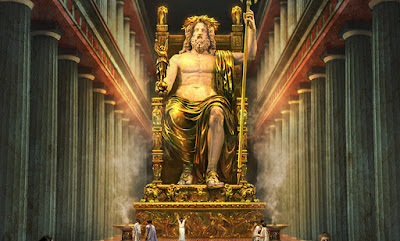Seven Wonder of the Ancient World: Statue of Zeus Edition
In the ancient world, there were many temples dedicated to Zeus, God of Gods and the King of the Gods. But there was only one temple to Zeus that housed one of the seven wonders of the ancient world. The Temple of Zeus at Olympia was home to one of greatest sculptural achievements of ancient history. The Statue of Zeus at Olympia represented the pinnacle of Classical sculptural design. A sculpture of ivory plates and gold panels over a wooden framework, it represented the god Zeus sitting on an elaborate cedar wood throne ornamented with ebony, ivory, gold and precious stones. No copy of the statue has ever been found, and details of its form are known only from ancient Greek descriptions and representations on coins. The great seated statue as fashioned by Phidias occupied half the width of the aisle of the temple built to house it.
The city-state of Olympia was a center of religious worship, and was also the birthplace of the Olympic Games. Believed to have begun in 776 BC, the Olympic Games demonstrated the physical prowess as well as the political strength of the participating Greek city-states. The Olympic Games were considered to be a part of religious rituals that revolved around the King of the Gods, Zeus.
In ancient times one of the Greeks most important festivals, The Olympic Games, was held every four years in honor of the King of their gods, Zeus. Like our modern Olympics, athletes traveled from distant lands, including Asia Minor, Syria, Egypt and Sicily, to compete. The Olympics were first started in 776 B.C. and held at a shrine to Zeus located on the western coast of Greece in a region called Peloponnesus. The games helped to unify the Greek city-states and a sacred truce was declared. Safe passage was given to all traveling to the site, called Olympia, for the season of the games. So it was only fitting that a grand temple and an even grander cult representation were constructed for the many Greeks who made pilgrimages there in order to worship their father god.
It was damaged in an earthquake in 170 B.C. and repaired. According to Suetonius, the Roman Emperor Caligula "gave orders that such statues of the gods as were especially famous for their sanctity or for their artistic merit, including that of Zeus at Olympia, should be brought from Greece, in order to remove their heads and put his own in their place." Before this could happen, the emperor was assassinated (AD 41); his "approaching murder was foretold by many prodigies. The statue of Jupiter at Olympia, which he had ordered to be taken to pieces and moved to Rome, suddenly uttered such a peal of laughter that the scaffolding collapsed and the workmen took to their heels."
Now, there are several statues that maintain the spirit of the Zeus at Olympia, one of the most famous of them is the statue in honor to Abraham Lincoln in the Lincoln Memorial in Washington D.C. In this statue Lincoln is depicted seated on a huge throne as well as Zeus in the legendary statue of Olympia
The statue of the Zeus at Olympia and its history has been from 2500 years ago, a great source of inspiration for artists of all times for the face of God and it is still now one of the most famous works of art of the history.
Do remember next year the Olympic is held in beautiful Brazil!!!










Comments
Post a Comment